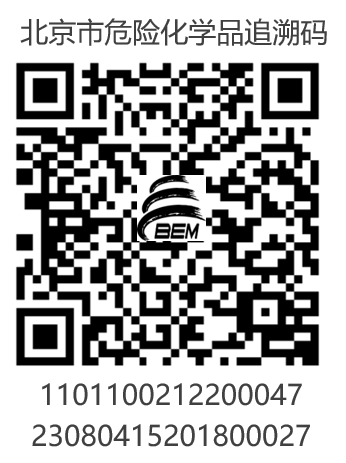In February 2024, the Shanghai Emergency Management Bureau and the Shanghai Transportation Commission officially released the "Notice on Advancing the Management on the Inventory of Hazardous Chemicals and the Loading and Unloading of Dangerous Goods through the Implementation of 'One Enterprise, One Product with One QR Code'" to require that Shanghai's hazardous chemicals enterprises generate and print/affix traceability codes, and complete the construction or transformation of the warehouse management system (Dynamic) for hazardous chemicals by December 31, 2024. With the implementation of Beijing's "Technical specifications for full-process traceability management of hazardous chemicals" (DB11/T 2196-2023) on April 1, 2024, many enterprises in multiple districts of Beijing have been required to start applying for and affixing traceability codes for hazardous chemicals.

The traceability code policies in Shanghai and Beijing can be considered as an upgrade of the national pilot work of "One Enterprise, One Product, One Code" forhazardous chemicals, bringing significant challenges for many domestic and foreign dangerous chemicals enterprises to comply. RXGC has compared the differences between the traceability code policies in Shanghai and Beijing (based on the released documents), for reference by enterprises and individuals.
Legal Basis & Guide
| Beijing | Shanghai |
|
Regulations
of Beijing Municipality on Work Safety Article 46 |
Regulations on the Safety Management of Hazardous Chemicals in Shanghai City
Article 19 |
|
|
Scope of Application
| Beijing | Shanghai |
| All hazardous chemicals in the Catalog of Hazardous Chemicals in China (2022) | Of the hazardous chemicals listed in the Catalog of Hazardous Chemicals in China, entry 1-2827 and 88 items listed in entry 2828 require mandatory coding. The other 2828 entries and hazardous chemical mixtures that meet the 70% principle do not require mandatory coding, but the warehouse management need to be reported. |
|
The hazardous chemicals with packaging produced in Beijing shall be retroactively labeled by the production unit. The packaging hazardous chemicals that circulate from the outside to Beijing shall be affixed by the first business unit in Beijing or coordinated by the supplier. |
The labels of chemicals produced, imported, filled, repacked and replaced within Shanghai shall be assigned a traceability code. The imported hazardous chemicals that pass customs clearance at the Shanghai port and circulate within Shanghai shall be assigned a traceability code after entering the warehouse of a licensed enterprise engaged in the operation of hazardous chemicals (with storage facilities and warehousing) in Shanghai (except those that are used as raw materials by the enterprise). |
Scope of Exemption
| Beijing | Shanghai |
|
Chemicals that are classified as precursors to the production of drugs, highly toxic, and explosives, as well as dangerous chemicals stored in gas cylinders, are already subject to the regulations set forth in the "DB 11/T 1904-2021 Standard for Electronic Tracking Management of Highly Toxic and Explosive Dangerous Chemicals" and the "DB 11/T 1530-2018 Technical Specification for Traceability of Dangerous Chemicals Stored in Gas Cylinders." These chemicals are not subject to the management requirements of this standard. Hazardous chemicals operated by enterprises in Beijing that have upstream and downstream suppliers or customers outside of Beijing are not subject to the management requirements of this standard. Information on bulk hazardous chemicals should be reported through the traceability system. |
|
Traceability System
| Beijing | Shanghai |
|
Beijing Emergency Management Bureau
Non-local enterprises |
Shanghai hazardous chemicals traceability code management subsystem Wechat public account "Shanghai Emergency Guard" |
Traceability Code
| Beijing | Shanghai |
|
One product, one code: For the same enterprise, the same hazardous chemicals, and the same batch, each package has a unique QR code.
|
One product, one batch, one code: For the same enterprise, the same hazardous chemicals, and the same specifications, each package has the same QR code.
|
Affixing Requirements
| Beijing | Shanghai |
| The traceability code should be affixed to the smallest packaging. If there are multiple layers of packaging, a multi-level traceability code should be applied and the traceability label should be affixed in layers. The system can automatically assign the child code on the bottle and the mother code on the outer box. | The traceability code should be printed and affixed in a standardized manner on the outer packaging of each segment of circulation in the hazardous chemicals. The code can also be printed on the pickup slip/order for transportation by tank trucks. |
Warehouse Management System (Dynamic)
| Beijing | Shanghai |
|
Not specified. The traceability process should, as much as possible, be achieved through data sharing by connecting with existing information systems, rather than duplicative data collection. |
Enterprises that have obtained permits for the production, use, or operation (with storage facilities or warehousing) of hazardous chemicals should build or improve a dynamic management system for hazardous chemicals in-and-out that meets the requirements, and connect it with the Shanghai municipal hazardous chemicals supervision and management information system. |
Implementation Date
| Beijing | Shanghai |
| Although the technical landmark has taken effect on April 1, 2024, there has been no official document released for full implementation. |
|
In comparison to Beijing's requirements, Shanghai's exemption scope and implementation date for hazardous chemicals traceability code are more specific. While the scope of applicable hazardous chemicals is basically the same for both, the impacted enterprises and product categories will definitely differ. Although Beijing's one product, one code policy may seem harder to implement, the application for traceability code is easier in Beijing than in Shanghai, with less information required. Both places mention supporting information system interconnection, which adds another compliance option for hazardous chemicals enterprises with a large variety of products. However, it is currently not possible for the hazardous chemicals traceability codes in Beijing and Shanghai to be interchangeable, which is not conducive to the nationwide circulation of goods.
CIRS can provide a one-stop solution for the Shanghai and Beijing hazardous chemicals traceability code and warehouse management system (Dynamic). If you need any assistance or have any questions, please get in touch with us via service@hfoushi.com.
Further Information



